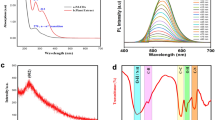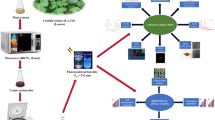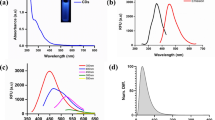Abstract
A hydrothermal method was employed for green synthesis of fluorescent carbon dots (GCDs) from Annona squamosa leaves. The synthesized GCDs were confirmed by microscopic and spectroscopic techniques such as: High Resolution Transmission Electron Microscopy (HR-TEM), Atomic Force Microscopy (AFM), UV–Vis spectrometry, Fluorescence spectrometry, X-Photoelectron Spectroscopy (XPS), X-ray Diffraction spectroscopy (XRD), and Fourier Transform Infrared Spectroscopy (FTIR). The produced GCDs had shown multiple properties, including massive antibacterial activity at concentration 200 μg/ml. The stabilization of human red blood cells served as a method to assess the anti-inflammatory activity. We also looked at how GCDs affected the angiogenesis process. The density of blood vessels was significantly decreased after treatment with GCDs, according to the results of the Chorio-Allantoic Membrane assay (p < 0.05). As per the study prepared GCDs from fallen leaves of Annona squamosa have multifunctional applications.
Graphical Abstract











Similar content being viewed by others
Data Availability
The datasets generated during and/or analyzed during the current study are available from the corresponding author on reasonable request.
References
Vibhute A, Patil T, Gambhir R, Tiwari AP (2022) Fluorescent carbon quantum dots: Synthesis methods, functionalization and biomedical applications. Appl Surf Sci 11:100311. https://doi.org/10.1016/j.apsadv.2022.100311
Komalavalli L, Amutha P, Monisha S (2019) A facile approach for the synthesis of carbon dots from Hibiscus sabdariffa & its application as bio-imaging agent and Cr (VI) sensor. Mater Today Proc 33:2279–2285. https://doi.org/10.1016/j.matpr.2020.04.195
Liu A, Cai H, Zeng Y, Chen Y, Yu X, Song J, Zeng P, Qu J, Guo J, Li H (2022) Nitrogen-doped carbon dots with high selectivity for hydrosulfide sensing and their living cells imaging. Analytica Chimica Acta 1225:340202. https://doi.org/10.1016/j.aca.2022.340202
Wang C et al (2021) Biocompatible sulfur nitrogen co-doped carbon quantum dots for highly sensitive and selective detection of dopamine. Colloids Surf B Biointerfaces 205:111874. https://doi.org/10.1016/j.colsurfb.2021.111874
Pebdeni AB, Hosseini M, Ganjali MR (2020) Fluorescent turn-on aptasensor of staphylococcus aureus based on the FRET between green carbon quantum dot and gold nanoparticle. Food Anal Methods 13(11):2070–2079. https://doi.org/10.1007/s12161-020-01821-4
Chen P, Peng J, Zhang Z, Wang X, Zhu X, Fan K, Luo P (2022) Solvent-dependent carbon dots for multifunctional sensing of temperature, pH, and proton pump inhibitors. Analytica Chimica Acta 1228:340341. https://doi.org/10.1016/j.aca.2022.340341
Vasimalai N et al (2018) Green synthesis of fluorescent carbon dots from spices for in vitro imaging and tumour cell growth inhibition. Beilstein J Nanotechnol 9(1):530–544. https://doi.org/10.3762/bjnano.9.51
KanthiGudimella K et al (2022) Novel synthesis of fluorescent carbon dots from bio-based Carica Papaya Leaves: Optical and structural properties with antioxidant and anti-inflammatory activities. Environ Res 204:111854. https://doi.org/10.1016/j.envres.2021.111854
Shahshahanipour M, Rezaei B, Ensafi AA, Etemadifar Z (2019) An ancient plant for the synthesis of a novel carbon dot and its applications as an antibacterial agent and probe for sensing of an anti-cancer drug. Mater Sci Eng C 98:826–833. https://doi.org/10.1016/j.msec.2019.01.041
Sachdev A, Gopinath P (2015) Green synthesis of multifunctional carbon dots from coriander leaves and their potential application as antioxidants, sensors and bioimaging agents. Analyst 140(12):4260–4269. https://doi.org/10.1039/c5an00454c
Bhavyasree PG, Xavier TS (2020) Green synthesis of Copper Oxide/Carbon nanocomposites using the leaf extract of Adhatoda vasica Nees, their characterization and antimicrobial activity. Heliyon 6(2):e03323. https://doi.org/10.1016/j.heliyon.2020.e03323
Yadav PK et al (2019) Green synthesis of fluorescent carbon quantum dots from Azadirachta indica leaves and their peroxidase-mimetic activity for the detection of H 2 O 2 and ascorbic acid in common fresh fruits. ACS Biomater Sci Eng 5(2):623–632. https://doi.org/10.1021/acsbiomaterials.8b01528
Surendran P, Lakshmanan A, Vinitha G, Ramalingam G, Rameshkumar P (2020) Facile preparation of high fluorescent carbon quantum dots from orange waste peels for nonlinear optical applications. Luminescence 35(2):196–202. https://doi.org/10.1002/bio.3713
Sharma N, Das GS, Yun K (2020) Green synthesis of multipurpose carbon quantum dots from red cabbage and estimation of their antioxidant potential and bio-labeling activity. Appl Microbiol Biotechnol 104(16):7187–7200. https://doi.org/10.1007/s00253-020-10726-5
Arkan E, Barati A, Rahmanpanah M, Hosseinzadeh L, Moradi S, Hajialyani M (2018) Green synthesis of carbon dots derived from walnut oil and an investigation of their cytotoxic and apoptogenic activities toward cancer cells. Adv Pharm Bull 8(1):149–155. https://doi.org/10.15171/apb.2018.018
Mehta VN, Jha S, Kailasa SK (2014) One-pot green synthesis of carbon dots by using Saccharum officinarum juice for fluorescent imaging of bacteria (Escherichia coli) and yeast (Saccharomyces cerevisiae) cells. Mater Sci Eng C 38(1):20–27. https://doi.org/10.1016/j.msec.2014.01.038
Amin N, Afkhami A, Hosseinzadeh L, Madrakian T (2018) Green and cost-effective synthesis of carbon dots from date kernel and their application as a novel switchable fluorescence probe for sensitive assay of Zoledronic acid drug in human serum and cellular imaging. Anal Chim Acta 7(1030):183–193. https://doi.org/10.1016/j.aca.2018.05.014
Ye Z, Li G, Lei J, Liu M, Jin Y, Li B (2020) One-step and one-precursor hydrothermal synthesis of carbon dots with superior antibacterial activity. ACS Appl Bio Mater 3(10):7095–7102. https://doi.org/10.1021/acsabm.0c00923
Katrancioglu N, Karahan O, Kilic AT, Altun A, Katrancioglu O, Polat ZA (2012) The antiangiogenic effects of levosimendan in a CAM assay. Microvasc Res 83(3):263–266. https://doi.org/10.1016/j.mvr.2012.01.002
Vibhute A, Nille O, Kolekar G, Rohiwal S, Patil S, Lee S, Tiwari AP (2022) Fluorescent carbon quantum dots functionalized by poly L-Lysine: efficient material for antibacterial, bioimaging and antiangiogenesis applications. J Fluoresc 1–2. https://doi.org/10.1007/s10895-022-02977-4
Nandi S, Ritenberg M, Jelinek R (2015) Bacterial detection with amphiphilic carbon dots. Analyst 140(12):4232–4237. https://doi.org/10.1039/c5an00471c
Zhang X, Wang J, Liu J, Wu J, Chen H, Bi H (2017) Design and preparation of a ternary composite of graphene oxide/carbon dots/polypyrrole for supercapacitor application: Importance and unique role of carbon dots. Carbon N Y 115:134–146. https://doi.org/10.1016/j.carbon.2017.01.005
Kumar A, Chowdhuri AR, Laha D, Mahto TK, Karmakar P, Sahu SK (2017) Green synthesis of carbon dots from Ocimum sanctum for effective fluorescent sensing of Pb2+ ions and live cell imaging. Sensors Actuators B Chem 242:679–686. https://doi.org/10.1016/j.snb.2016.11.109
Malapermal V, Botha I, Krishna SBN, Mbatha JN (2017) Enhancing antidiabetic and antimicrobial performance of Ocimum basilicum, and Ocimum sanctum (L.) using silver nanoparticles. Saudi J Biol Sci 24(6):1294. https://doi.org/10.1016/j.sjbs.2015.06.026
Kitimu SR, Kirira P, Abdille AA, Sokei J, Ochwang’i D, Mwitari P, Makanya A, Maina N (2022) Anti-angiogenic and anti-metastatic effects of biogenic silver nanoparticles synthesized using azadirachta indica. Adv Biosci Biotechnol 13(12):188–206. https://doi.org/10.4236/abb.2022.134010
Acknowledgements
The authors have appreciated the support from the intramural university project (project no DYPES/DU/R&D/2021/274), D. Y. Patil Education Society, Kolhapur, India. The authors are also grateful to MJPRF given by Mahatma Jyotiba Phule Research and training Institute for financial support.
Funding
This work was supported by the D. Y. Patil Education Society, Kolhapur, India [grant number- DYPES/DU/R&D/2021/274]. The authors also acknowledge the funding support from Mylab discovery solutions pvt. ltd., Pune.
Author information
Authors and Affiliations
Contributions
Dr. Arpita Tiwari conceived the presented idea. Ms. Anuja Vibhute developed the theory, carried out experiments, wrote manuscript with support from Dr. Arpita Tiwari. Ms. Tejaswini Patil helped in formal data analysis. Mr. Dhanaji Malavekar, Mr. Shubham Patil, Prof. Seunghyun Lee contributed in characterization and data analysis.
Corresponding author
Ethics declarations
Ethics and Declaration Statement
Not applicable.
Consent to Participate
Not applicable.
Consent for Publication
Not applicable.
Competing Interest
The authors have no competing interest to declare.
Additional information
Publisher's Note
Springer Nature remains neutral with regard to jurisdictional claims in published maps and institutional affiliations.
Rights and permissions
Springer Nature or its licensor (e.g. a society or other partner) holds exclusive rights to this article under a publishing agreement with the author(s) or other rightsholder(s); author self-archiving of the accepted manuscript version of this article is solely governed by the terms of such publishing agreement and applicable law.
About this article
Cite this article
Vibhute, A., Patil, T., Malavekar, D. et al. Green Synthesis of Fluorescent Carbon Dots from Annona squamosa Leaves: Optical and Structural Properties with Bactericidal, Anti-inflammatory, Anti-angiogenesis Applications. J Fluoresc 33, 1619–1629 (2023). https://doi.org/10.1007/s10895-023-03159-6
Received:
Accepted:
Published:
Issue Date:
DOI: https://doi.org/10.1007/s10895-023-03159-6




